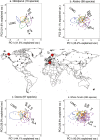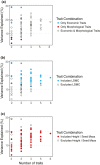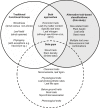Traditional plant functional groups explain variation in economic but not size-related traits across the tundra biome
- PMID: 31007605
- PMCID: PMC6472633
- DOI: 10.1111/geb.12783
Traditional plant functional groups explain variation in economic but not size-related traits across the tundra biome
Abstract
Aim: Plant functional groups are widely used in community ecology and earth system modelling to describe trait variation within and across plant communities. However, this approach rests on the assumption that functional groups explain a large proportion of trait variation among species. We test whether four commonly used plant functional groups represent variation in six ecologically important plant traits.
Location: Tundra biome.
Time period: Data collected between 1964 and 2016.
Major taxa studied: 295 tundra vascular plant species.
Methods: We compiled a database of six plant traits (plant height, leaf area, specific leaf area, leaf dry matter content, leaf nitrogen, seed mass) for tundra species. We examined the variation in species-level trait expression explained by four traditional functional groups (evergreen shrubs, deciduous shrubs, graminoids, forbs), and whether variation explained was dependent upon the traits included in analysis. We further compared the explanatory power and species composition of functional groups to alternative classifications generated using post hoc clustering of species-level traits.
Results: Traditional functional groups explained significant differences in trait expression, particularly amongst traits associated with resource economics, which were consistent across sites and at the biome scale. However, functional groups explained 19% of overall trait variation and poorly represented differences in traits associated with plant size. Post hoc classification of species did not correspond well with traditional functional groups, and explained twice as much variation in species-level trait expression.
Main conclusions: Traditional functional groups only coarsely represent variation in well-measured traits within tundra plant communities, and better explain resource economic traits than size-related traits. We recommend caution when using functional group approaches to predict tundra vegetation change, or ecosystem functions relating to plant size, such as albedo or carbon storage. We argue that alternative classifications or direct use of specific plant traits could provide new insights for ecological prediction and modelling.
Keywords: cluster analysis; community composition; ecosystem function; plant functional groups; plant functional types; plant traits; tundra biome; vegetation change.
Figures






Similar articles
-
Global plant trait relationships extend to the climatic extremes of the tundra biome.Nat Commun. 2020 Mar 12;11(1):1351. doi: 10.1038/s41467-020-15014-4. Nat Commun. 2020. PMID: 32165619 Free PMC article.
-
Plant traits poorly predict winner and loser shrub species in a warming tundra biome.Nat Commun. 2023 Jun 28;14(1):3837. doi: 10.1038/s41467-023-39573-4. Nat Commun. 2023. PMID: 37380662 Free PMC article.
-
Plant traits inform predictions of tundra responses to global change.New Phytol. 2019 Mar;221(4):1742-1748. doi: 10.1111/nph.15592. Epub 2018 Dec 24. New Phytol. 2019. PMID: 30444539 Review.
-
Snow is an important control of plant community functional composition in oroarctic tundra.Oecologia. 2019 Nov;191(3):601-608. doi: 10.1007/s00442-019-04508-8. Epub 2019 Sep 14. Oecologia. 2019. PMID: 31522244 Free PMC article.
-
Revisiting the Holy Grail: using plant functional traits to understand ecological processes.Biol Rev Camb Philos Soc. 2017 May;92(2):1156-1173. doi: 10.1111/brv.12275. Epub 2016 Apr 22. Biol Rev Camb Philos Soc. 2017. PMID: 27103505 Review.
Cited by
-
Geographic Origin and Functional Group Type Affect the Decomposability of Peatland Plant Litter Through Biochemical Properties.Ecol Evol. 2025 Jul 7;15(7):e71758. doi: 10.1002/ece3.71758. eCollection 2025 Jul. Ecol Evol. 2025. PMID: 40625328 Free PMC article.
-
Concurrent anthropogenic stressors affect plant-soil systems with different plant diversity levels.New Phytol. 2025 Aug;247(4):1897-1911. doi: 10.1111/nph.70275. Epub 2025 Jun 4. New Phytol. 2025. PMID: 40468774 Free PMC article.
-
Climate Change Dependence in Ex Situ Conservation of Wild Medicinal Plants in Crete, Greece.Biology (Basel). 2023 Oct 11;12(10):1327. doi: 10.3390/biology12101327. Biology (Basel). 2023. PMID: 37887037 Free PMC article.
-
Global plant trait relationships extend to the climatic extremes of the tundra biome.Nat Commun. 2020 Mar 12;11(1):1351. doi: 10.1038/s41467-020-15014-4. Nat Commun. 2020. PMID: 32165619 Free PMC article.
-
Plant traits poorly predict winner and loser shrub species in a warming tundra biome.Nat Commun. 2023 Jun 28;14(1):3837. doi: 10.1038/s41467-023-39573-4. Nat Commun. 2023. PMID: 37380662 Free PMC article.
References
-
- Bjorkman, A. , Myers‐Smith, I. , Elmendorf, S. , Normand, S. , Thomas, H. , Alatalo, J. , … Zamin, T. (2018a). Tundra Trait Team: A database of plant traits spanning the tundra biome. Global Ecology and Biogeography. 27, 1402–1411.
-
- Bjorkman, A. D. , Myers‐Smith, I. H. , Elmendorf, S. C. , Normand, S. , Rüger, N. , Beck, P. S. , … Georges, D. (2018b). Plant functional trait change across a warming tundra biome. Nature, 562, 57–62. - PubMed
-
- Bliss, L. C. , Heal, O. W. , & Moore, J. J. (1981). Tundra ecosystems: A comparative analysis. New York, NY: Cambridge University Press.
